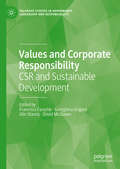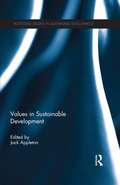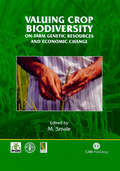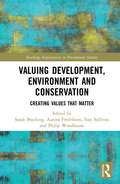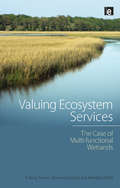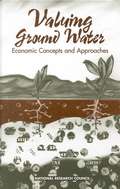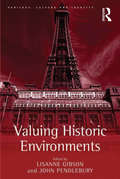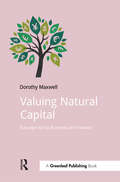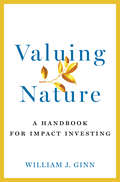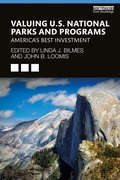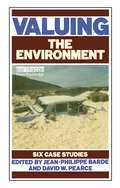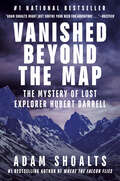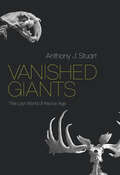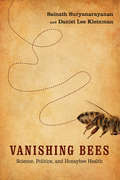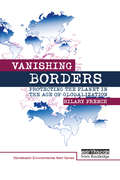- Table View
- List View
Value of Information in the Earth Sciences
by Tapan Mukerji Eidsvik, Jo and Mukerji, Tapan and Bhattacharjya, Debarun Jo Eidsvik Debarun BhattacharjyaGathering the right kind and the right amount of information is crucial for any decision-making process. This book presents a unified framework for assessing the value of potential data gathering schemes by integrating spatial modelling and decision analysis, with a focus on the Earth sciences. The authors discuss the value of imperfect versus perfect information, and the value of total versus partial information, where only subsets of the data are acquired. Concepts are illustrated using a suite of quantitative tools from decision analysis, such as decision trees and influence diagrams, as well as models for continuous and discrete dependent spatial variables, including Bayesian networks, Markov random fields, Gaussian processes, and multiple-point geostatistics. Unique in scope, this book is of interest to students, researchers and industry professionals in the Earth and environmental sciences, who use applied statistics and decision analysis techniques, and particularly to those working in petroleum, mining, and environmental geoscience.
Values and Corporate Responsibility: CSR and Sustainable Development (Palgrave Studies in Governance, Leadership and Responsibility)
by Georgiana Grigore Alin Stancu David McQueen Francisca FaracheIn this book we capture and explore different aspects of value in corporate social responsibility (CSR). This includes the historical development of value in CSR, how value is linked to a positive vision of the future, and how it is communicated by a range of private and public organisations to various audiences. The book contrasts corporate strategic value with co-operative value, and community value in the context of sustainable development. It explains how leaders’ values can drive responsible business practice and enhance social cohesion, solidarity and resilience in fractured and unequal communities. The book asks the reader to consider what value means in CSR for business and society, where it comes from and how it is enacted, alongside its broader purpose and value to the community. Finally, the book presents CSR as a global project by noting how values are cultural and how sustainability has become an urgent international priority.
Values in Sustainable Development: Values In Sustainable Development (Routledge Studies in Sustainable Development)
by Jack AppletonTo enhance sustainable development research and practice the values of the researchers, project managers and participants must first be made explicit. Values in Sustainable Development introduces and compares worldviews and values from multiple countries and perspectives, providing a survey of empirical methods available to study environmental values as affected by sustainable development. The first part is methodological, looking at what values are, why they are important, and how to include values in sustainable development. The second part looks at how values differ across social contexts, religions and viewpoints demonstrating how various individuals may value nature from a variety of cultural, social, and religious points of view. The third and final part presents case studies ordered by scale from the individual and community levels through to the national, regional and international levels. These examples show how values can motivate, be incorporated into and be an integral part of the success of a project. This thought-provoking book gives researchers, students and practitioners in sustainable development a wealth of approaches to include values in their research.
Valuing Crop Biodiversity: On-farm Genetic Resources and Economic Change
by Melinda SmaleIn agricultural systems, a diversity of crops and varieties in essential to combat the risks farmers face from pests, diseases and variations in climate. Crop biodiversity also underpins the range of dietary needs and services that consumers demand as economies change. There is growing concern, however, about declining services that consumers demand as economies change. This book contributes to a better understanding of the challenges involved in maintaining local crop biodiversity within a rapidly changing global food system, and to policy debates related to the Convention on Biological Diversity. It provides empirical studies conducted in the field with farmers and crop scientists across a range of agricultural economies and income levels, applying economic tools and methods for valuing and managing crop biodiversity on farms.
Valuing Development, Environment and Conservation: Creating Values that Matter (Routledge Explorations in Development Studies)
by Philip Woodhouse Sarah Bracking Sian Sullivan Aurora FredriksenPolicy-makers are increasingly trying to assign economic values to areas such as ecologies, the atmosphere, even human lives. These new values, assigned to areas previously considered outside of economic systems, often act to qualify, alter or replace former non-pecuniary values. Valuing Development, Environment and Conservation looks to explore the complex interdependencies, contradictions and trade-offs that can take place between economic values and the social, environmental, political and ethical systems that inform non-monetary valuation processes. Using rich empirical material, the book explores the processes of valuation, their components, calculative technologies, and outcomes in different social, ecological and conservation domains. The book gives reasons for why economic calculation tends to dominate in practice, but also presents new insights on how the disobedient materiality of things and the ingenuity of human and non-human agencies can combine and frustrate the dominant economic models within calculative processes. This book highlights the tension between, on the one hand, a dominant model that emphasises technical and ‘universalising’ criteria, and on the other hand, valuation practice in specific local contexts which is more likely to negotiate criteria that are plural, incommensurable and political. This book is perfect for researchers and students within development studies, environment, geography, politics, sociology and anthropology who are looking for new insights into how processes of valuation take place in the 21st century, and with what consequential outcomes.
Valuing Ecosystem Services: The Case of Multi-functional Wetlands (Routledge Studies In Ecosystem Services Ser.)
by R. Kerry Turner Stavros GeorgiouEcosystem services can be broadly defined as the aspects of ecosystems that provide benefits to people. This book provides guidance on the valuation of ecosystem services, using the case of multifunctional wetlands to illustrate and make recommendations regarding the methods and techniques that can be applied to appraise management options. It provides a review of ecosystem service valuation rationale, including its importance from both a policy and project appraisal perspective, and a useful reference when considering policy and appraisal of ecosystem management options. It shows how legal obligations and other high-level management targets should be taken into account in valuation exercises, thus giving important policy context to the management options. The authors set out what they call an Ecosystem Services Approach to the full appraisal of the role of ecosystem services in the economy and society. Although concentrating on wetlands, the approaches suggested provide an assessment framework that can be applied to other types of ecosystem assets.
Valuing Ground Water: Economic Concepts and Approaches
by Committee on Valuing Ground WaterBecause water in the United State has not been traded in markets, there is no meaningful estimate of what it would cost if it were traded. But failing to establish ground water's value--for in situ uses such as sustaining wetlands as well as for extractive uses such as agriculture--will lead to continued overuse and degradation of the nation's aquifers.In Valuing Ground Water an interdisciplinary committee integrates the latest economic, legal, and physical knowledge about ground water and methods for valuing this resource, making it comprehensible to decisionmakers involved in Superfund cleanup efforts, local wellhead protection programs, water allocation, and other water-related management issues. Using the concept of total economic value, this volume provides a framework for calculating the economic value of ground water and evaluating tradeoffs between competing uses of it. Included are seven case studies where ground-water valuation has been or could be used in decisionmaking.The committee examines trends in ground-water management, factors that contribute to its value, and issues surrounding ground-water allocation and legal rights to its use. The book discusses economic valuation of natural resources and reviews several valuation methods.Presenting conclusions, recommendations, and research priorities, Valuing Ground Water will be of interest to those concerned about ground-water issues: policymakers, regulators, economists, attorneys, researchers, resource managers, and environmental advocates.
Valuing Historic Environments (Heritage, Culture and Identity)
by John PendleburyThis volume brings together an interdisciplinary team of leading scholars to discuss frameworks of value in relation to the preservation of historic environments. Starting from the premise that heritage values are culturally and historically constructed, the book examines the effects of pluralist frameworks of value on how preservation is conceived. It questions the social and economic consequences of constructions of value and how to balance a responsive, democratic conception of heritage with the pressure to deliver on social and economic objectives. It also describes the practicalities of managing the uncertainty and fluidity of the widely varying conceptions of heritage.
Valuing Natural Capital: Future Proofing Business and Finance (Doshorts Ser.)
by Dorothy MaxwellCompanies that will succeed in the long-term are integrating natural and social capital into their business model now. Natural capital, the resources and critical support services nature provides, underpins our entire global economy. Yet despite its vast social and economic value, the many benefits of natural capital are often assumed to be "free". The future shock for business is the potential for profit to be wiped out as natural capital is internalized through regulation and markets. Freshwater, forests and biodiversity are being consumed at an alarming rate, and critical support systems such as the ability to regulate climate are failing. As these and other sustainability challenges develop, businesses and their investors need to understand their role in maintaining natural capital and their natural capital risks and opportunities. The language of finance provides a useful approach for communicating trade-offs and prioritizing sustainability at CFO, CEO and board level: companies who "future-proof" now will position themselves to thrive in a resource-constrained world. They will mitigate risk, secure their resource supplies, create long-term value and enhance their resilience, reputation and competitive advantage. This book provides a succinct introduction to natural capital: what natural capital is and how it links to other capitals; the business case for using it in decision-making; where natural capital accounting and valuation fit in the sustainability and financial toolbox; and what real life early adopters of natural capital in business are doing. Views from natural capital leaders across business, finance, accounting, government, research and NGO communities illustrate the theory with practice. Included: Quotes and case examples from CFOs, CEOs and Heads of Sustainability in early adopter businesses (Kingfisher Group, Dow Chemical Company, The Crown Estate, Patagonia®, United Utilities and Marks & Spencer) and financial institutions (Inter-American Development Bank, Citi Group and Credit Suisse).
Valuing Nature: A Handbook for Impact Investing
by William GinnAs the world faces unprecedented challenges such as climate change and biodiversity loss, the resources needed far outstrip the capabilities of nonprofits and even governments. Yet there are seeds of hope—and much of that hope comes from the efforts of the private sector. Impact investing is rapidly becoming an essential tool, alongside philanthropy and government funding, in tackling these major problems. Valuing Nature presents a new set of nature-based investment areas to help conservationists and investors work together.NatureVest founder William Ginn outlines the emerging private sector investing opportunities in natural assets such as green infrastructure, forests, soils, and fisheries. The first part of Valuing Nature examines the scope of nature-based impact investing while also presenting a practical overview of its limitations and the challenges facing the private sector. The second part of the book offers tools for investors and organizations to consider as they develop their own projects and tips on how nonprofits can successfully navigate this new space. Case studies from around the world demonstrate how we can use private capital to achieve more sustainable uses of our natural resources without the unintended consequences plaguing so many of our current efforts.Valuing Nature provides a roadmap for conservation professionals, nonprofit managers, and impact investors seeking to use market-based strategies to improve the management of natural systems.
Valuing U.S. National Parks and Programs: America’s Best Investment
by Linda J. Bilmes John B. LoomisThis book provides the first comprehensive economic valuation of U.S. National Parks (including monuments, seashores, lakeshores, recreation areas, and historic sites) and National Park Service (NPS) programs. The book develops a comprehensive framework to calculate the economic value of protected areas, with particular application to the U.S. National Park Service. The framework covers many benefits provided by NPS units and programs, including on-site visitation, carbon sequestration, and intellectual property such as in education curricula and filming of movies/ TV shows, with case studies of each included. Examples are drawn from studies in Santa Monica Mountains National Recreation Area, Golden Gate National Recreation Area, Everglades National Park, and Chesapeake Bay. The editors conclude with a chapter on innovative approaches for sustainable funding of the NPS in its second century. The framework serves as a blueprint of methodologies for conservationists, government agencies, land trusts, economists, and others to value public lands, historical sites, and related programs, such as education. The methodologies are relevant to local and state parks, wildlife refuges, and protected areas in developed and developing countries as well as to national parks around the world. Containing a series of unique case studies, this book will be of great interest to professionals and students in environmental economics, land management, and nature conservation, as well as the more general reader interested in National Parks.
Valuing the Environment: Six Case Studies (Environmental and Resource Economics Set)
by Jean-Philippe Barde David W. PearceThis is the second in a pair of economic texts commissioned by the OECD in the field of environmental economics; The Pearce Report: Blueprint for a Green Economy puts the role which monetary evaluation of environmental costs and benefits can play firmly into the public eye. This book goes further and looks at six countries where such evaluation techniques are applied and at the obstacles to their further use. The case studies, written by leading experts in each nation, show how these methods are being taken up in the UK, Norway and Italy and the ways in which they are already extensively in use in the USA, Germany and the Netherlands. The authors also describe the obstacles to their use - the lack of knowledge of environmental economics at government level; the competition from other government priorities; and, the failure of environmental groups to grasp the importance of financial evaluation to their cause. But, as this book makes clear, significant advances are being made, both in the implementation of these economic techniques and, above all, in striking and yet further developments in economic thinking.
Valuing the Environment: Six case studies (Environmental And Resource Economics Set Ser.)
by Jean-Philippe Barde David W. PearceThe 'Pearce Report', Blueprint for a Green Economy, puts the role which monetary evaluation of environmental costs and benefit. can play firmly into the public eye. This book goes further and looks at six countries where such evaluation techniques are applied and at the obstacles to their further use. The case studies, written by leading experts in each nation, show how these methods are being taken up in the UK, Norway and Italy and the ways in which they are already extensively in use in the USA, Germany and the Netherlands. The authors also describe the obstacles to their use, the lack of knowledge of environmental economics at government level; the competition from other government priorities; the failure of environmental groups to grasp the importance of financial evaluation to their cause. But, as this book makes clear, significant advances are being made, both in the implementation of these economic techniques and, above all, in striking and yet further developments in economic thinking.
Vanadium Isotopes: A Proxy for Ocean Oxygen Variations (Elements in Geochemical Tracers in Earth System Science)
by Sune G. NielsenVanadium isotope ratios (51V/50V) have potential to provide information about changes in past ocean oxygen contents. In particular, V isotopes may find utility in tracing variations at non-zero oxygen concentrations because the redox couple that controls V elemental and isotopic abundances in seawater (vanadate-vanadyl) appears to operate around 10M O2. This characteristic sets V isotopes apart from many other metal isotope redox proxies that require more reducing conditions to register significant changes in their isotope budgets. The oxygen abundance sensitivity range of V isotopes suggests that this paleoproxy could be particularly useful in tracing marine oxygenation changes throughout the Phanerozoic and potentially beyond.
Vanadium in Soils and Plants (Advances in Trace Elements in the Environment)
by Jörg RinklebeVanadium is an essential element for humans and animals. The toxicity of vanadium at higher concentrations could be a global environmental concern and a significant issue for both environmental protection and economic benefits. The relevance of anthropogenic vanadium in the environment has increased significantly in recent years due to an increased demand for vanadium in high-temperature industrial activities. This book summarizes vanadium’s current research and explains its behavior and mobilization in the environment, especially in soils, sediments, water and plants. Through case studies from various countries, it discusses critical limits set and risk assessment approaches and remediation approaches of vanadium-contaminated soils. FEATURES Provides a comprehensive overview of vanadium in the total environment Covers the role of vanadium in various environments such as soils, sediments, water and plants Includes bioavailability studies and further case studies from various countries around the world Focuses on a better understanding of biogeochemical processes of vanadium Is written by international experts who present the current stage of the knowledge including innovative remediation and management approaches of vanadium-contaminated sites This book will be of use to upper-level undergraduate and graduate students taking courses in soil science, environmental science, soil ecology, water science, plant science, ecotoxicology, geology and geography as well as scientists, lecturers, environmental and technical engineers, ecologists, applied ecological scientists and managers.
Vanished Beyond the Map: The Mystery of Lost Explorer Hubert Darrell
by Adam ShoaltsCanada&’s greatest modern-day explorer sets out into the arctic wilderness to solve a mystery more than 100 years old.In November 1910, explorer Hubert Darrell vanished in the uncharted wilds of the Northwest Territories. A prospector who had been swept up in the Klondike Gold Rush, Darrell later made his name as an expert guide, trapper, and restless wanderer who ventured where few others dared. At a time when travel by dogsled in the North was the norm, Darrell became legendary for traversing thousands of kilometres alone and on foot; ranging over mountains and across windswept tundra from Alaska to Hudson Bay. During his epic journeys, he helped rescue sailors trapped in sea ice, led Mounties on their patrols, and even guided some of the era&’s most famous explorers. Roald Amundsen, the first person to reach the South Pole, held Darrell in awe, remarking once that with men like him, he could go to the moon. Contemporaries regarded Darrell as the hardiest, most competent explorer of his day. Despite clues reported by Inuit trappers and Mounted Police inquiries, his fate remains a mystery. While his disappearance sparked headlines around the world, Darrell&’s name would soon also vanish from the history books, ironically, just as surely as he had in the wild.Yet Darrell left behind a trail of letters, journals, and hand-drawn maps. With these faded clues and his zeal for adventure, Adam Shoalts retraces Darrell&’s forgotten routes through the wilderness, searching for cabin ruins and old campsites. He unearths water-stained records and tracks down elderly individuals in the hopes that they might remember someone who&’d known Darrell. Part detective story, part biography, and part first-person adventure narrative, Vanished Beyond the Map combines expeditions with historical research to solve one of exploration history&’s enduring cold cases—the mystery of Hubert Darrell.
Vanished Giants: The Lost World of the Ice Age
by Anthony J. StuartFeaturing numerous illustrations, this book explores the many lessons to be learned from Pleistocene megafauna, including the role of humans in their extinction, their disappearance at the start of the Sixth Extinction, and what they might teach us about contemporary conservation crises. Long after the extinction of dinosaurs, when humans were still in the Stone Age, woolly rhinos, mammoths, mastodons, sabertooth cats, giant ground sloths, and many other spectacular large animals that are no longer with us roamed the Earth. These animals are regarded as “Pleistocene megafauna,” named for the geological era in which they lived—also known as the Ice Age. In Vanished Giants: The Lost World of the Ice Age, paleontologist Anthony J. Stuart explores the lives and environments of these animals, moving between six continents and several key islands. Stuart examines the animals themselves via what we’ve learned from fossil remains, and he describes the landscapes, climates, vegetation, ecological interactions, and other aspects of the animals’ existence. Illustrated throughout, Vanished Giants also offers a picture of the world as it was tens of thousands of years ago when these giants still existed. Unlike the case of the dinosaurs, there was no asteroid strike to blame for the end of their world. Instead, it appears that the giants of the Ice Age were driven to extinction by climate change, human activities—especially hunting—or both. Drawing on the latest evidence provided by radiocarbon dating, Stuart discusses these possibilities. The extinction of Ice Age megafauna can be seen as the beginning of the so-called Sixth Extinction, which is happening right now. This has important implications for understanding the likely fate of present-day animals in the face of contemporary climate change and vastly increasing human populations.
Vanishing America
by Miles A. PowellMiles Powell explores how early conservationists became convinced that the vitality of America's white races depended on preserving the wilderness. Some conservationists embraced scientific racism, eugenics, and restrictive immigration laws, but these activists also laid the groundwork for the many successes of the modern environmental movement.
Vanishing Bees: Science, Politics, and Honeybee Health
by Daniel Lee Kleinman Sainath SuryanarayananIn 2005, beekeepers in the United States began observing a mysterious and disturbing phenomenon: once-healthy colonies of bees were suddenly collapsing, leaving behind empty hives full of honey and pollen. Over the following decade, widespread honeybee deaths--some of which have come to be called Colony Collapse Disorder (CCD)--have continued to bedevil beekeepers and threaten the agricultural industries that rely on bees for pollination. Scientists continue to debate the causes of CCD, yet there is no clear consensus on how to best solve the problem. Vanishing Bees takes us inside the debates over widespread honeybee deaths, introducing the various groups with a stake in solving the mystery of CCD, including beekeepers, entomologists, growers, agrichemical companies, and government regulators. Drawing from extensive interviews and first-hand observations, Sainath Suryanarayanan and Daniel Lee Kleinman examine how members of each group have acquired, disseminated, and evaluated knowledge about CCD. In addition, they explore the often-contentious interactions among different groups, detailing how they assert authority, gain trust, and build alliances. As it explores the contours of the CCD crisis, Vanishing Bees considers an equally urgent question: what happens when farmers, scientists, beekeepers, corporations, and federal agencies approach the problem from different vantage points and cannot see eye-to-eye? The answer may have profound consequences for every person who wants to keep fresh food on the table.
Vanishing Borders: Protecting the planet in the age of globalization (The Worldwatch Environmental Alert Series)
by Hilary FrenchThe world is shrinking faster than ever. Goods, money, microbes, pollution, people and ideas are crossing boundaries ever more frequently. The implications for our future and for the health of the planet are profound. Vanishing Borders outlines the ecological challenges posed and then goes on to define the necessary strategies for tackling them. Presently, national governments are singularly ill-equipped for tackling transitional environmental problems-from ozone depletion to soaring trade in commodities such as timbre- problems which are climbing ever higher on the international political agenda. Industrial and developing countries are on a collision course over climate change, and water shortages are creating tensions in several parts of the world. The author argues that only a worldwide commitment to strengthening treaties and institutions needed to integrate ecological considerations into the rules of global commerce holds out hope. Over 200 international environmental treaties exist but most need more stringent conditions and enforcement, and continuing support from NGO and business communities. Significantly, the digital revolution, integral in itself to processes to globalization, offers channels through which powerful coalitions can effect change. The book provides a compelling and accessible analysis and a clear plan of action in pursuit of environmental stability. Originally published in 2000
Vanishing Ice: Glaciers, Ice Sheets, and Rising Seas
by Vivien GornitzThe Arctic is thawing. In summer, cruise ships sail through the once ice-clogged Northwest Passage, lakes form on top of the Greenland Ice Sheet, and polar bears swim farther and farther in search of waning ice floes. At the opposite end of the world, floating Antarctic ice shelves are shrinking. Mountain glaciers are in retreat worldwide, unleashing flash floods and avalanches. We are on thin ice—and with melting permafrost’s potential to let loose still more greenhouse gases, these changes may be just the beginning.Vanishing Ice is a powerful depiction of the dramatic transformation of the cryosphere—the world of ice and snow—and its consequences for the human world. Delving into the major components of the cryosphere, including ice sheets, valley glaciers, permafrost, and floating ice, Vivien Gornitz gives an up-to-date explanation of key current trends in the decline of ice mass. Drawing on a long-term perspective gained by examining changes in the cryosphere and corresponding variations in sea level over millions of years, she demonstrates the link between thawing ice and sea-level rise to point to the social and economic challenges on the horizon. Gornitz highlights the widespread repercussions of ice loss, which will affect countless people far removed from frozen regions, to explain why the big meltdown matters to us all. Written for all readers and students interested in the science of our changing climate, Vanishing Ice is an accessible and lucid warning of the coming thaw.
Vanishing Sands: Losing Beaches to Mining
by William J. Neal Orrin H. Pilkey Keith C. Pilkey Norma J. Longo Nelson G. Rangel-Buitrago Hannah L. HayesIn a time of accelerating sea level rise and increasingly intensifying storms, the world’s sandy beaches and dunes have never been more crucial to protecting coastal environments. Yet, in order to meet the demands of large-scale construction projects, sand mining is stripping beaches and dunes, destroying environments, and exploiting labor in the process. The authors of Vanishing Sands track the devastating impact of legal and illegal sand mining over the past twenty years, ranging from Africa, Asia, and the Caribbean to South America and the eastern United States. They show how sand mining has reached crisis levels: beach, dune, and river ecosystems are in danger of being lost forever, while organized crime groups use deadly force to protect their illegal mining operations. Calling for immediate and widespread resistance to sand mining, the authors demonstrate that its cessation is paramount for saving not only beaches, dunes, and associated environments but also lives and tourism economies everywhere.
Vapor Intrusion Simulations and Risk Assessments
by Qiang Chen Yijun YaoThis book introduces key concepts in modeling and risk assessments of vapor intrusion, a process by which the subsurface volatile contaminants migrate into the building of concern. Soil vapor intrusion is the major exposure pathway for building occupants to chemicals from the subsurface, and its risk assessments determine the criteria of volatile contaminants in soil/groundwater in brownfield redevelopment. The chapters feature the recent advances in vapor intrusion studies and practices, including analytical and numerical modeling of vapor intrusion, statistical findings of United States Environmental Protection Agency’s Vapor Intrusion Database and Petroleum Vapor Intrusion Databases, the challenges of preferential pathways, and the application of building pressure cycling methods, and field practices of vapor intrusion risk assessments at developed contaminated sites and in brownfield redevelopment. This volume also summarizes the advantages and limits of current applications in vapor intrusion risk assessment, laying the groundwork for future research of better understanding in risk characterization of soil vapor intrusion using models. Written by experts in this field, Vapor Intrusion Simulations and Risk Assessments will serve as an invaluable reference for researchers, regulators, and practitioners, who are interested in perceiving the basic knowledge and current advances in risk assessments of soil vapor intrusion.
Vaquita: Science, Politics, and Crime in the Sea of Cortez
by Brooke BessesenIn 2006, vaquita, a diminutive porpoise making its home in the Upper Gulf of California, inheritedthe dubious title of world's most endangered marine mammal.Nicknamed "panda of the sea” for their small size and beguiling facial markings, vaquitas have been in decline for decades, dying by the hundreds in gillnets intended for commercially valuable fish, as wellas for anendangered fish called totoaba. When international crime cartels discovered a lucrative trade in the swim bladders of totoaba, illegal gillnetting went rampant, and now the lives of the few remaining vaquitas hang in the balance.Author Brooke Bessesen takes us on a journey to Mexico's Upper Gulf region to uncover the story. She interviewed townspeople, fishermen, scientists, and activists, teasing apart a complex story filled with villains and heroes, a story whose outcome is unclear.When diplomatic and political efforts to save the little porpoise failed, Bessesen followed a team of veterinary experts in a binational effort to capture the last remaining vaquitas and breed them in captivity—the best hope for their survival. In this fast-paced, soul-searing tale, she learned that there are no easy answers when extinction is profitable.Whether the rescue attempt succeeds or fails, the world must ask itself hard questions. When vaquita and the totoaba are gone, the black market will turn to the next vulnerable species. What will we do then?
Variational Principles in Physics: From Classical to Quantum Realm (SpringerBriefs in Physics)
by Tamás Sándor BiróThis book is an English translation from a Hungarian book designed for graduate and postgraduate students about the use of variational principles in theoretical physics. Unlike many academic textbooks, it dashes across several lecture disciplines taught in physics courses. It emphasizes and demonstrates the use of the variational technique and philosophy behind the basic laws in mechanics, relativity theory, electromagnetism, and quantum mechanics. The book is meant for advanced students and young researchers in theoretical physics but, also, more experienced researchers can benefit from its reading.

